|
Shoreham
Beach: Coastal Fringe
Shoreham
Beach is a shingle spit about three miles long, separated from town of
Shoreham-by-Sea (Sussex) by the River
Adur, which been has deflected eastwards by the
longshore
drift over the centuries. Wood and rock groynes have been installed
to stabilise the moving shingle and to minimise erosion and prevent flooding.

From
the turn of the century the creeping permanent development and re-development
of the natural fringing beach at Shoreham has gradually covered the main
shingle bank, leaving a narrow strip, squeezed between houses and sea.
This
flat strip of seemingly lifeless pebbles that has once more held out against
a winter sea, is set to surprise and delight us, as seeds and roots of
last years flowering respond to longer days, and find nourishment and moisture.
In April and early May they burst upon us with a brilliant flowering border
adapted to the harsh conditions.
by David Wood (Shoreham Beach)
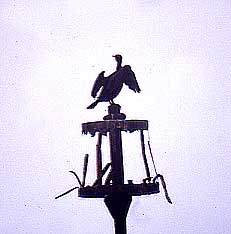 Birds
of the Shingle Birds
of the Shingle
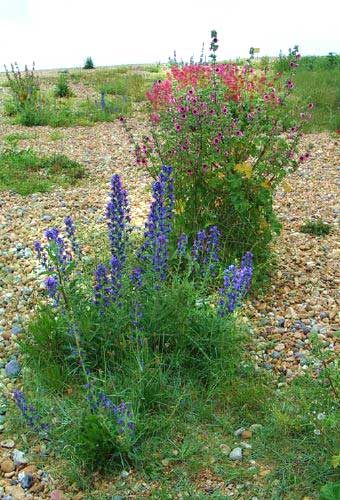
Greenfinches,
Goldfinches
and
Linnets
arrive in large mixed flocks, Greenfinches predominating. They find
a a good supply of seed from the Sea Kale
and also from the Dock
that grows here. How the finches crack open the Sea
Kale seed is a bit of a mystery.
Also
we do have regular visits from Wheatear,
and occasionally Black Redstarts.
The
Crows
are a serious menace to Ringed Plover,
predating eggs and chicks. They are probably the most significant
limiting factor on Ringed Plover breeding success.
by
David Wood (Shoreham Beach)
WILDLIFE
REPORTS
CLICK
ON THIS TEXT FOR THE WILDLIFE REPORTS 2004 ET SEQ.
24
November 2003
There
were a couple of birdwatchers on the shingle beach, each with high powered
scopes on rigid tripods (the stability is important even in a gentle breeze)
looking out to sea. One of them reported thirty or so Guillemots
and Razorbills flying past which seems
what could be expected at this time of the year.
13
November 2003
Foraging
on the shingle just above the reach of the gently lapping sea, or just
perched on the tideline, a small flock of twenty Turnstones
between the rock groynes just east of the Church of the Good Shepherd (on
Shoreham Beach), were the most I had seen in Shoreham together.
There
was still one or two isolated Thrift
plants in flower by the beach huts.
9 October
2003
A
couple of Eider Ducks
were seen at low tide on the sand by the outfall pipe near Brooklands
Boating Lake on the Lancing/Worthing border.
Report
by June Brown
7
October 2003
On
the syenite rock groynes on Southwick beach, four Turnstones
flew off at my approach, but I was able to get within throwing distance,
their red legs and black and white wing patterns very clearly seen.
19
September 2003
The
mildly poisonous berries of the Bittersweet
turn from green to red
in autumn.

|

|
|
Bittersweet
|
Rock
Samphire
|
2 September
2003
Large
White Butterflies (50+) were common on
the Sea Kale on the shingle beach from Shoreham to Lancing, and
ventured into gardens to feed on Buddleia.
There was a large amount of black on the upper wings of the female butterflies,
that were often chased by one or more, usually two males, a distinct pitch
black on the wing corners, with two large large black spots as well.
Large
White Video Brief (click on this text)
The
shingle shore had lost its summer sparkle. The Yellow-horned
Poppy was looking bedraggled, the yellow
dull and dirty but it was about the only plant in flower.
30
August 2003
A
single Wheatear
was on the railings parallel (same latitude) to Carrot's Cafe between the
road and Southwick beach (on the approach from Shoreham Harbour lock gates).
I managed a good naked eye view of the white rear and pale pinkish breast.
The bird looked plump and well fed enough for the long journey back to
Africa.
10
July 2003
About
a dozen Gatekeeper Butterflies
and about the same number of Small Skippers*
blown about in the breeze, and up to a score of Cabbage
Whites (species not differentiated) fluttered
over the shingle vegetation near the Church of the Good Shepherd. The white
butterflies will be very common for the rest of the summer around the Sea
Kale. (*confirmed, although a few Large
Skippers could be included.)
A
Common
Blue Butterfly fluttered around the bushes
by the riverbank where the main drag of houseboats are. (This butterfly
behaved like and was originally thought to be a Holly
Blue, but it was probably too early for the
second brood.)
Adur
Butterflies
28
June 2003
The
Childing
Pink,
Petrorhagia
nanteuilii, is in flower at Silver
Sands (TQ 229 048)
on Shoreham Beach. There are about fifty of these
tiny easily overlooked plants, three or four with the distinctive double
flowers. The first plants must have been flowering for up to a couple of
weeks ago, and they are not yet in their prime. This site is one of just
two remaining sites for this flower in Sussex (the other is a larger area
at Pagham), although they may have been planted elsewhere. Kidney
Vetch was also observed on the tiny patch
of dunes.

The
yellow flowers are of the Silver Ragwort
20
June 2003
The
Sea
Thrift has faded and now it is the Viper's
Bugloss
that makes an extensive and brilliant
blue display, complimented by the Yellow-horned
Poppy, Common Mallow, and
Tree Mallow.
11
June 2003
Shoreham
Beach is now, arguably, at its colourful best with the Yellow-horned
Poppy Common Mallow, and
Viper's
Bugloss enriching the colour variety.
A few
butterflies
fluttered around and I made a note of a Small
Tortoiseshell Butterfly that settled.
Buff-tailed
Bumblebees harnessed the shingle
flowers, the Tree Mallow
in particular.
 29
May 2003 29
May 2003
This
wild
Geranium
plant is the same colour as the Childing Pink
(not in flower yet) and also found on the
Silver
Sands but it is a different plant: Geranium
molle with the book name of Dove's-foot
Crane's-bill. This plant could outcompete
the rare Childing Pink but
it shows no signs of doing so quite yet.
28
May 2003
An
unusual dead lizard was discovered in my Shoreham beach garden, missing
its tail (I fear one of my cats had had it). It didn't look like either
of the two native species - the Common Lizard
or the Sand Lizard.
It was black with very bright green spots on and about 10 cm without the
tail. I'm fairly convinced it is a Podarcis
muralis (Laurenti, 1768) the Wall Lizard.
NB: Wall
Lizards were released by a herpetologist on
to Shoreham beach several years ago.
Old
Fort Lizards
24
May 2003

Shoreham
beach is in colourful bloom, with the naturalised alien Red
Valerian particularly noticeable in contrast
to the white flowers of the Sea Kale (visited
by a Small White Butterfly),
the pink of the Sea Thrift,
the yellow of the Sow Thistle,
the blue of Viper's Bugloss (only
an occasional flower so far), all in contrast to the various shades of
brown of the pebbles.
 14
May 2003 14
May 2003
A
couple of Wheatears
on Lancing Beach Green were the first I had seen this spring.
Tree
Mallow was in flower on the cyclepath
to the east of the green.
12
May 2003
There
is some rather puzzling engineering work going on on the shingle foreshore
at the eastern of Widewater Lagoon, which seems
to also involve an offshore ship of some kind. Shingle and water is being
pumped over a small section of the beach.
The
photograph on the left shows what looks like mainly coloured water coming
out the pipeline which is discolouring the sea, but a lesser extent than
the water discharges from Shoreham harbour on to Southwick beach.
8 April
2003
In
the chilly east wind, the signs of spring on the trees bring a brightness
in the weak sun. On the beach between the
pebbles, the wild plants push forth new shoots.
Shingle
Flowers of Shoreham Beach
19
March 2003
A
steady stream of orange-tailed bumblebees
were
observed flying eastwards over the shingle beach to the seaward edge of
Widewater
Lagoon. Over a period of two hours, a bee must have passed every 30
seconds and I estimated the total numbers passing at about 136. Later in
the afternoon a smaller fly-pass occurred.
NB: The
species was probably the Red-tailed
(Jewel)
Bumble
Bee,
Bombus
lapidarius.
7 February
2003
A
couple of Purple
Sandpipers were on the Inner East Pier
(by the Old Fort) of Shoreham Harbour, a couple of hours before high water.
21
January 2003
Due
southerly winds up the Gale Force 7 on this exceptionally breezy day. But
the strandline showed nothing special. A dozen egg purses of the Thornback
Ray (Mermaid's Purses)
were washed up in the space of 25 metres on the Old Fort beach. By Ferry
Road beach, Shoreham, over a dozen Cuttlefish
bones lay scattered about with the flotsam in
the space of 25 metres. These
are Sepia officinalis as only this, the commonest of the large cuttlefish
are found in Sussex seas.
BMLSS
Cuttlefish and Cuttlebones
BMLSS
Beachcombing
16
January 2003
A
small wren-sized bird flew just like a wren and it looked a bit like a
miniature chaffinch but with a much more colourful head. It was in the
greenery at the sea end of a large garden at the eastern end (TQ
186 037) of Lancing Beach Green. Alas, the
sighting was very brief, but this was my first ever observation of a Goldcrest,
the smallest British bird. (The bird looked to me more like a Firecrest,
but this latter bird is 25 times less likely than the former.)

20
December 2002
A
quick look over at the rock groynes I spied an Oystercatcher
perched on the new rock boulders at Lancing, on the shore by Widewater.
On an unusually deserted promenade I flushed out a group of beautiful Goldfinches
and some very raucous Sparrows.
12
December 2002
A
flick of the white, or grey, outer tail feathers as I think it was a Meadow
Pipit that flew between the beach huts
to the new rock groynes on the shingle beach at Lancing (TQ
204 042) adjacent to the east end of the flooded
Widewater Lagoon. My identification was based mainly on the repeated call
as it flew away. Could it have been a Water
Pipit?
Trouble
with Pipits Identification
Rock
and Water Pipits (Identification Hints)
Rock
& Water Pipits Messages
7 November
2002
Near
the Old Fort (TQ 233 045),
Shoreham
beach, on the strandline to the west of
the harbour pier, five Turnstones
in black (actually dark brown) with grey-white breasts and distinctive
red legs and large feet, were foraging amongst the accumulated seaweed
and occasional dead Dogfish, seashells, broken fishing pots and single
dried out Mermaid's Purse (Thornback Ray).
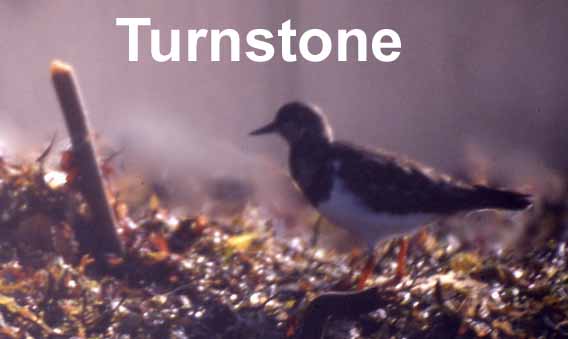
The
Turnstones
could be seen very clearly and closer than other waders, confident of their
own camouflage which was not nearly as efficient as that of the Ringed
Plover or Pied Wagtail, the commoner birds
of the shingle beach and strandline in the colder months. The bill is shorter
than that of the Purple Sandpiper
and the underneath of the Turnstone
is pure white. Then to my surprise I disturbed a Red
Admiral Butterfly amongst the seaweed.
The anglers were catching Whiting, Flounders and small Bass
from the harbour arm.
BMLSS
Fish
31
October 2002
The
sudden flight of a "little
brown bird" with a glimpse of the white outer
tail feathers but in an unusual place on Lancing beach (flying from Beach
Green to the shingle banks) (TQ 185 037) where
the bird perched on a wooden sea defence structure above high tide level
and I could see the full brown speckled colour of this bird, which is rarely
possibly in the meadows. It looked larger than a sparrow (size favours
a Rock Pipit).
My favourite identification is a Water Pipit,
although it was probably a Meadow
Pipit.
(The other uncommon winter visitor pipit on this coast is the Scandinavian
Rock Pipit, but this is a lighter coloured
bird, noticeable as a Rock Pipit because of its grey outer tail feathers.)
Chirms
of 20+ Goldfinches flew
around their usual bushes between Widewater Lagoon
and the sea, and in adjoining bushes, the House
Sparrows made a cacophonic racket as a
Kestrel
flew overhead.
19
October 2002
A
chirm of over 30 Goldfinches
flocked near the Church of Good Shepherd on Shoreham beach.
5
October 2002
Down
the beach this morning to check the sea state for diving when I noticed
I was being watched by a seal, bobbing in front of me. I first saw it in
the surge five metres from the shore, in front of the new sea defence works,
east of the Widewater Lagoon. A fisherman in
a boat must have just passed the seal moments before I had arrived, maybe
he gave the seal some titbits?
It
was a Harbour (Common) Seal, Phoca
vitulina, as I have photographed Grey
Seals many times and this seal is different.
Previous
Seal Report 2002
BMLSS
Seals
Seas
off Sussex
Grey
Seal Report 1996
27
September 2002
Hundreds
of Swallows
flew eastwards over the beach and Widewater Lagoon
this morning. I couldn't say if they were circling, perhaps getting as
far as Shoreham harbour and returning. Every one I saw was heading east.
I would estimate numbers at between 1 and 20 per minute. They were actively
feeding, some flying head high, sometimes swooping to ground level. Some
passed me within a couple of feet. Small groups of Goldfinches
occasionally took to the air as I passed the scrub where they gathered.
September
2002
The
new rock defences on the shingle beach are erected on Widewater beach with
rocks* brought in by barge across the North Sea from Norway.
Five
great heaps of rock looking like small volcanic islands sat on the beach
the last time I looked. Each waiting to be sculpted into a new groyne structure.
I stood watching the contractors as they were using a mechanical claw to
set rocks into place in a mound that will become one of the new groynes.
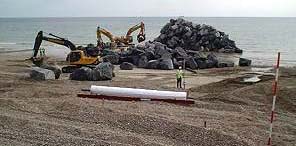
It
was extraordinary to see how much effort went in to get one piece of rock
to fit exactly the right position at the top of the newly formed mound.
Imagine having to build a rockery with pieces that weigh several tonnes
each. All the exposed pieces, it seems, must be secure and form an overall
smooth appearance, so that if you take a line and hold it against the mound,
no individual rocks break the line or leave a large hollow. Or perhaps
imagine if it were rendered with cement, a rock would not protrude through.
That seems to be the degree to which construction was taken. One piece
of stone was tried, rolled, twisted, turned and finally rejected and another
selected and the process repeated until just the right fit was obtained.
There must be a huge safety factor at stake here. If one piece of rock
was not quite secure, a person could be trapped and maimed by an unexpected
shift if they inadvertently found the loose piece.
(* Larvikite,
a type of syenite)
New
Rock Sea Defences on Widewater beach
22
August 2002
An
immigrant Clouded Yellow Butterfly
fluttered in the breeze by the beach huts near Beach Green, Shoreham Beach.
Adur
Butterflies
27
May 2002
A
pod of dolphins, probably Bottle-nosed Dolphins, were seen off Lancing
beach. They appeared dark in colour, described as black rather than
the grey of the life-sized artificial dolphin on display at Adur
World Oceans Day 2002.
Report
by Russell at Adur World Oceans Day 2002
BMLSS
Whales and Dolphins
Sussex
Dolphins
Sea
Watch Foundation
1
June 2002
A
huge one metre in diameter jellyfish with a humped appearance was discovered
washed up on
Shoreham beach due of south of Coronation Green. This is the species known
by several common names: Barrel Jellyfish, Football Jellyfish, Root-mouthed
Jellyfish, and with the scientific name of Rhizostoma
octopus. This is an unusual sighting off the Sussex coast,
but this year tens of thousands have been seen off the coast of Cornwall,
with many more washed up on the coast of Devon and Dorset.
Adur
Nature Notes (Spring 2002) for Shoreham Beach Nature Reports
Other
Reports
BMLSS
Jellyfish
31
May 2002
A
pod of dolphins, probably Bottle-nosed Dolphins, were seen off Shoreham
beach. They appeared dark in colour, described as black rather than the
grey of the life-sized artificial dolphin on display at Adur
World Oceans Day 2002.
Report
by Russell at Adur World Oceans Day 2002
BMLSS
Whales and Dolphins
25
April 2002
The
distinctive white underside
of at least four immigrant Wheatears
were unmistakable on the seaward side of Widewater,
perching on the wooden posts (that comprise part of the sea defences running
parallel with the sea) before the bird flew rapidly around, before embarking
on their destination flights inland to the downs.
A
clump of Squid eggs were washed ashore on Lancing
beach.
4 April
2002
On
the warmest day of the year, I spotted my first white butterfly of the
year flying in off the shingle foreshore by the
beach huts south of Beach Green, Shoreham Beach. It was probably a Small
White, that could have been feeding as
a caterpillar on the Sea Kale.
Later more white butterflies were seen in one and twos in the town gardens
of Lancing.
15
February 2002
A
small formation of four wading birds flew rapidly over the shingle shore
and imported Larvikite (a type of syenite)
sea defence rocks (TQ 213 044)
opposite Beach Green, (by the beach huts) in mid-afternoon. These birds
could be clearly seen with a white wing bar when flying away (not like
the white rear edge of the Redshank)
and there call was a clear "chik-tik-tik"
and
this probably mean that they are Turnstones.
A flock of three Turnstones
have also been reported from Southwick Beach.

7 September
2001
Wheatears
fly between the dock plants and beach huts on Shoreham beach prior to migration.
There
were Red Admiral Butterflies (4+)
and hundreds of Small White Butterflies
around
the shingle plants and flying strongly in the breeze.
15
July 2001
At
the Old Fort
(TQ
234 046), the Common
Lizards,
Lacerata
vivipara, with exceptionally mottled markings,
have found new places to hide after the flint wall has been repaired. The
exceptionally speckled markings of the lizard are found in the European
Wall Lizard, Podarcis muralis.
(This latter species were kept in the back garden of a house in Old Fort
Road and could be escapes. However, lizards were definitely present in
the 1960s on the walls of the Old Fort and this pre-dated the presence
of lizards in the garden of a herpetologist.)
Earlier
Report of the Flint Wall Repairs
Postscript:
these lizards have now been definitely identified as the Wall
Lizard, Podarcis
muralis.
Local
Lizard Comparison Photographs
11
July 2001
All
boats remain in harbour as the beach shingle is rolled about by the Fresh
Breeze (Force 5 +) without
rain, with many white horses. The shingle that
had been levelled with the renovation to the Inner West Arm of Shoreham
Harbour sea defences south of Soldier's Point, near the Old Fort, last
year, had now been reformed by the wind and returned to its former undulations,
with the return of the common shingle plants including Sea
Kale, Sea Beet, Yellow-horned
Poppy, Sea
Campion, Spear-leaved Orache and the common
weed of wild places, the Sow Thistle
was abundant.
Beaufort
Scale (sea)
The
wind speed was later (June 2002) checked with the recorded figures which
showed a mean average of a Moderate Breeze (Force 4) with a maximum of
a Strong Breeze (Force 6).
Beaufort
Scale (BMLSS)
Shoreham
Beach Weather Reports
28
June 2001
Shoreham
Beach Nature Reserve
There
will be meeting to discuss the future of the vegetated
shingle at Shoreham Beach, with experts from
English Nature, Adur District Council and West Sussex County Council. The
question of Nature Reserve status will be discussed.
The
meeting is at the Church of the Good Shepherd Hall and starts at
7:00 pm.
The idea
of the Shoreham Beach Nature Reserve received a mixed reception,
with the majority in support, many undecided and a few objectors.
14
June 2001
 The
shingle
beach at Shoreham beach along to the Widewater
is a colourful sight with Red Valerian
(red and white) , Viper's Bugloss
(blue), Sea Thrift (pink),
Sea
Kale (white), Tree
Mallow (crimson, not so much as usual),
Yellow-horned
Poppy,
Silver
Ragwort and a few garden flowers particularly
colourful as expected during the best month of June. A party of school
children, pencils and pads in their hand were on a field trip near the
Church of the Good Shepherd. The
shingle
beach at Shoreham beach along to the Widewater
is a colourful sight with Red Valerian
(red and white) , Viper's Bugloss
(blue), Sea Thrift (pink),
Sea
Kale (white), Tree
Mallow (crimson, not so much as usual),
Yellow-horned
Poppy,
Silver
Ragwort and a few garden flowers particularly
colourful as expected during the best month of June. A party of school
children, pencils and pads in their hand were on a field trip near the
Church of the Good Shepherd.
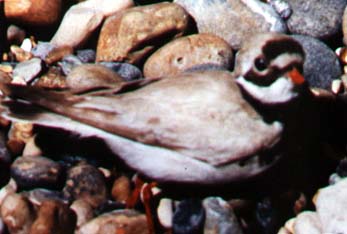 11
June 2001 11
June 2001
Offshore
from Brooklands Boating Lake, (1 mile east of Worthing
Pier) the
Ringed Plover
reveals itself by its swift running over the shingle. Without moving it
is too well camouflaged and difficult to spot. The summer residents birds
and much plumper than the lean winter visitors. As the tide ebbs and the
water recedes, more (a half dozen in 50 metres of sand) of these small
birds appear on the emerging sand flats.
15
April 2001
I
received a report via the RSPCA of three young sharks washed up on the
beach at either Lancing or Worthing. A size was not mentioned. I assume
these are Lesser-spotted Dogfish, Scyliorhinus
canicula, which are so commonly washed ashore dead in all months of
the year that they scarcely warrant a special mention. The specimen above
was discovered intact near the Old Fort a couple of months ago, before
it had been spotted by the gulls that scavenge along the strandline.
21
March 2001
Not
exactly spring, but still a pleasant still day at 10° C and little
sign of the mini-blizzard of yesterday.
Work
has begun on repairing the flint wall of the Old
Fort of Shoreham Beach (constructed c. 1857) by Dave Smith of Flintman
of Lewes. The Common Lizards, well
known to Shoreham children, have been displaced from their prime
holes in the wall, and have skittered off to new habitats.
(TQ 234 044)
Full
Story and Photograph
Flintman
on Flint (Link)
Postscript:
these lizards have now been definitely identified as the Wall
Lizard, Podarcis
muralis.
Local
Lizard Comparison Photographs
19
February 2001
A
flash of red indicated the male Black
Redstart flitting
between the beach huts south of Beach Green, Shoreham Beach. It perched
on a metre-high pole sticking out of the shingle beach where it looked
black silhouetted against the morning sky. A couple of the brownish female
birds were also reported on the same day.

Old
Fort
12
February 2001
Two
badly decomposed Dolphins were washed up on Shoreham
Beach, Sussex. They were badly decomposed but were probably Common
Dolphins, Delphinus delphis.
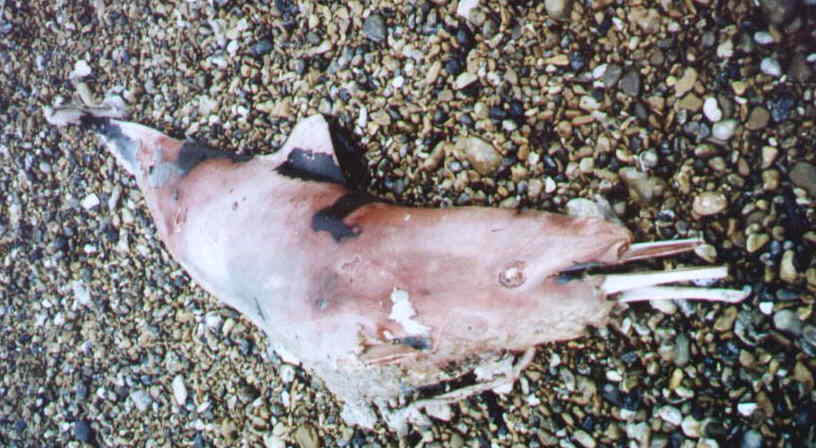
Photograph
by Steve Savage (Sea Watch Foundation)
Click
on the flipper for a close-up
A Porpoise,
just over a metre long, was washed at nearby Worthing.
Sussex
Dolphins
Sussex
Cetaceans 2001
Sussex
Sea Watch Foundation News 2001
16
August 2000
The
lizard originally identified as the European Wall Lizard, Podarcis
muralis, which poked its head out of flint wall in which a sprig of
Bittersweet was growing, on the Old Fort, Shoreham
Beach*is almost certainly an adult Common
(or Viviparous) Lizard,
Zootoca
vivipara.
Postscript:
these lizards have now been definitely identified as the Wall
Lizard, Podarcis
muralis.
Local
Lizard Comparison Photographs
It
is found in the rest of the Adur area, e.g. near Cuckoo's Corner (TQ 202
069). Judging by the number the cats kill, Common Lizards occur frequently
in the towns of gardens of Shoreham, as well as
Slow
Worms.
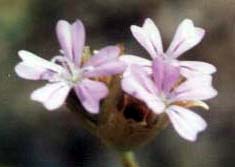 31
July 2000 31
July 2000
A
Clouded
Yellow Butterfly
was spotted on a Childing Pink
still in flower in the minute area of sand dunes (TQ
229 048) remaining on Shoreham Beach. These
rare plants seem to have increased in number, but are still under threat
from encroaching vegetation.
13
December 1999
A
meeting at Adur Civic Centre, Shoreham-by-Sea, was held to outline
the idea of a Vegetated
Shingle Nature Reserve on Shoreham Beach. The turnout was 56 interested
people. The questionnaire returned a 78% census in favour of the concept.
The public included many beach hut owners.
Neil
Mitchell (WSCC), Steve Berry (English Nature), Steve Gilbert (RSPB), Jeremy
Sergeant (Adur DC Leisure) were represented on the panel, chaired by Geoff
Howitt (Adur DC, Chair, Labour, St. Mary's Ward, Shoreham-by-Sea).
Co-ordinator:
Hayley
Tuppenny (send comments to this EMail).
The
photographic display by David Wood consisted of a large selection of shingle
plants on Shoreham Beach. The bird pictures were by Stanley Allen.
Vegetated
Shingle Nature Reserve Web Site
Shoreham
Beach (Shingle Plants)
Nature
Notes
27
May 1999
Marion
Wood (BMLSS) spotted a pod of about six Dolphins
100 metres off Shoreham Beach, Sussex, in the early evening with at least
three jumping out of the water at one time. They swam very quickly east
towards Brighton.
Cetacean
Page
1999
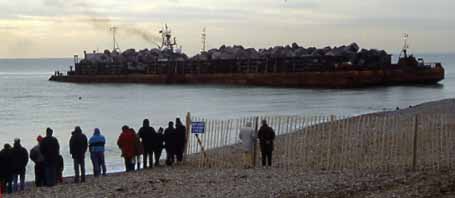
The
rock defences on the shingle beach were strengthened with additional rocks*brought
in by barge across the North Sea from Norway. The rocks were deposited
on the shore and rearranged by a JCB to hinder the erosion and
longshore
drift.
(*Larvikite,
a type of syenite)
c.
October? 1998
A
Boar
Fish,
Capros aper,was
washed up dead on Shoreham beach, Sussex, with the identity confirmed by
the Natural History Museum in London. The dried fish has been preserved
as an ornament.
Report
on
7 November 2002
by Viv Smith (Shoreham Beach)
2002
Report
Chalk
&
Flint
About
85 million years ago Sussex was covered by a warm sea. Sedimentary deposits
of coccoliths (microscopic plankton with a calcium carbonate shell) laid
down the chalk which is the rock of the South Downs of south-east England.
The flint probably formed from the dissolved remains of ancient sponge
siliceous spicules and was deposited at a later date into gaps and beds
in the chalk when the silica then solidified. When the friable chalk was
eroded the flint remained, subsequently rounded into spherical and ovoid
pebbles by the action of the waves grinding the pebbles against each other.
(simplified
explanation
for upper layers of chalk)
Chalk
Facts
Fossil
Sea Urchin Echinocorys scutatus
Fossil
Bivalve Spondylus spinosa (pic).
Butterflies:
| Clouded
Yellow |
Colias croceus |
| Large White |
Pieris brassicae |
| Common
Blue

|
Polyommatus icarus |
| Small White |
Pieris rapae |
Adur
Valley Butterflies
Link to FLOWERING PLANTS OF THE SHINGLE |

 Birds
of the Shingle
Birds
of the Shingle
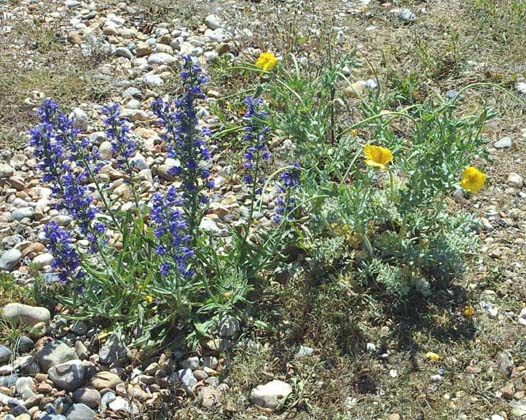
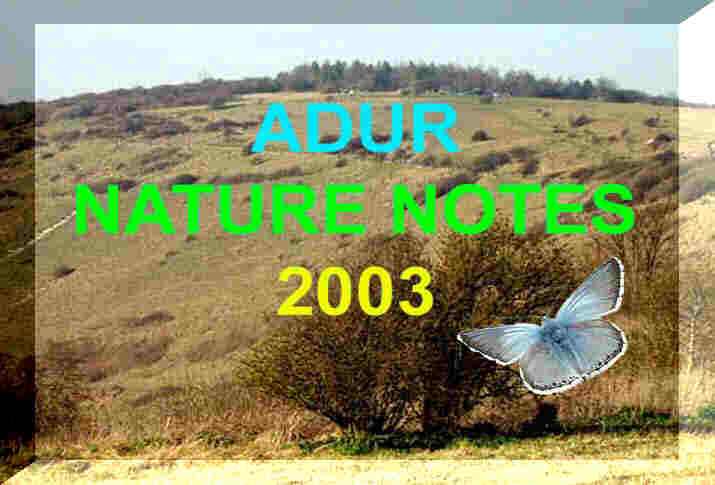













 31
July 2000
31
July 2000


